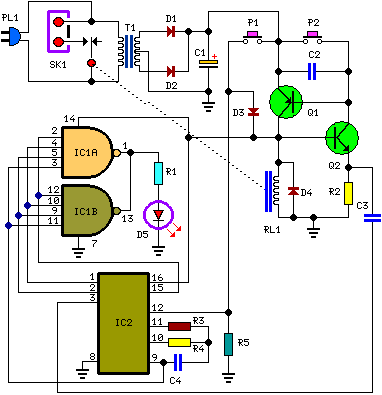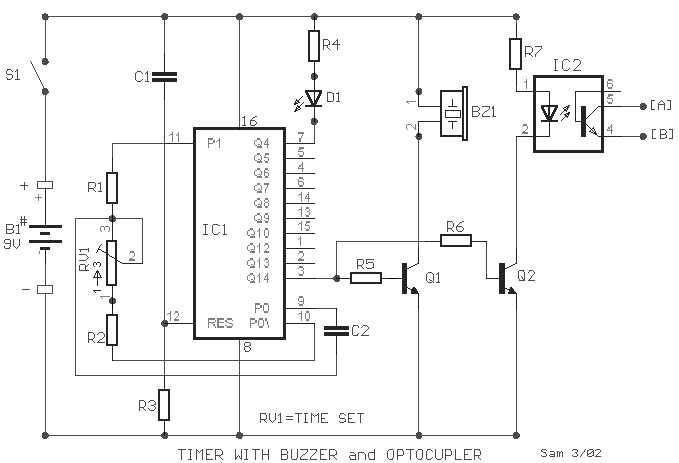
bedside lamp timer schematics

Q1 and Q2 create an ALL-ON ALL-OFF circuit that, when in the off state, draws negligible current. P1 initiates the circuit, activating the relay and powering the two integrated circuits (ICs). The lamp is energized through the relay switch, and IC2 is reset with a positive voltage applied to pin 12. IC2 begins oscillating at a frequency determined by resistor R4 and capacitor C4. With the specified values, pin 3 goes high after approximately 30 minutes, deactivating the circuit through capacitor C3. During the six minutes prior to shutdown, the LED blinks due to the connections of IC1 to pins 1, 2, and 15 of IC2. The blinking frequency is generated by the oscillator in IC2 at pin 9. The two gates of IC1 are connected in parallel to increase current sourcing capacity. If desired, a piezo sounder can be connected to pins 1 and 14 of IC1. Timing adjustments can be made by altering the values of C4 and/or R4.
The circuit comprises a dual transistor configuration (Q1 and Q2) that acts as a switch, effectively controlling the power to the load (lamp) and the ICs. The relay, activated by P1, serves as the primary mechanism for switching the circuit on and off. In the initial state, when the circuit is powered, the relay closes, allowing current to flow to the lamp and the integrated circuits. IC2, upon receiving a reset signal at pin 12, begins its oscillation cycle, which is crucial for timing functions within the circuit.
The frequency of oscillation is determined by the RC time constant formed by R4 and C4. The choice of these components directly influences the duration before pin 3 transitions high, which subsequently turns off the entire circuit after the designated time period of approximately 30 minutes. The blinking LED serves as a visual indicator of the operational status of the circuit, providing feedback during the countdown to shutdown. The frequency of the blinking is derived from the output of IC2 at pin 9, which controls the timing of the LED's on-off cycle.
IC1 is configured with two gates in parallel to enhance the current capacity available for driving additional loads, such as a piezo sounder, which can be integrated into the circuit for auditory feedback. This versatility allows for modifications to the circuit based on user requirements. The timing characteristics of the circuit can be easily adjusted by selecting different values for R4 and C4, enabling customization of the operational duration and blinking frequency to suit specific applications.Q1 and Q2 form an ALL-ON ALL-OFF circuit that in the off state draws no significant current. P1 starts the circuit, the relay is turned on and the two ICs are powered. The lamp is powered by the relay switch, and IC2 is reset with a positive voltage at pin 12. IC2 starts oscillating at a frequency set by R4 and C4. With the values shown, pin 3 goe s high after around 30 minutes, turning off the circuit via C3. During the c6 minutes preceding turn-off. The LED does a blinking action by connections of IC1 to pins 1, 2 & 15 of IC2. Blinking frequency is provided by IC2 oscillator at pin 9. The two gates of IC1 are wired in parallel to source more current. If required, a piezo sounder can be connected to pins 1 & 14 of IC1. Obviously, timings can be varied changing C4 and/or R4 values. 🔗 External reference
The circuit comprises a dual transistor configuration (Q1 and Q2) that acts as a switch, effectively controlling the power to the load (lamp) and the ICs. The relay, activated by P1, serves as the primary mechanism for switching the circuit on and off. In the initial state, when the circuit is powered, the relay closes, allowing current to flow to the lamp and the integrated circuits. IC2, upon receiving a reset signal at pin 12, begins its oscillation cycle, which is crucial for timing functions within the circuit.
The frequency of oscillation is determined by the RC time constant formed by R4 and C4. The choice of these components directly influences the duration before pin 3 transitions high, which subsequently turns off the entire circuit after the designated time period of approximately 30 minutes. The blinking LED serves as a visual indicator of the operational status of the circuit, providing feedback during the countdown to shutdown. The frequency of the blinking is derived from the output of IC2 at pin 9, which controls the timing of the LED's on-off cycle.
IC1 is configured with two gates in parallel to enhance the current capacity available for driving additional loads, such as a piezo sounder, which can be integrated into the circuit for auditory feedback. This versatility allows for modifications to the circuit based on user requirements. The timing characteristics of the circuit can be easily adjusted by selecting different values for R4 and C4, enabling customization of the operational duration and blinking frequency to suit specific applications.Q1 and Q2 form an ALL-ON ALL-OFF circuit that in the off state draws no significant current. P1 starts the circuit, the relay is turned on and the two ICs are powered. The lamp is powered by the relay switch, and IC2 is reset with a positive voltage at pin 12. IC2 starts oscillating at a frequency set by R4 and C4. With the values shown, pin 3 goe s high after around 30 minutes, turning off the circuit via C3. During the c6 minutes preceding turn-off. The LED does a blinking action by connections of IC1 to pins 1, 2 & 15 of IC2. Blinking frequency is provided by IC2 oscillator at pin 9. The two gates of IC1 are wired in parallel to source more current. If required, a piezo sounder can be connected to pins 1 & 14 of IC1. Obviously, timings can be varied changing C4 and/or R4 values. 🔗 External reference





